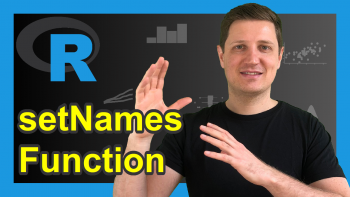Select Data Frame Column Using Character Vector in R (Example)
In this R programming tutorial you’ll learn how to extract a data frame variable based on a character string.
Table of contents:
- Creating Example Data
- Example: Select Column with [] Instead of $-Operator
- Video, Further Resources & Summary
Let’s just jump right in…
Creating Example Data
First, let’s create some example data:
data <- data.frame(x1 = 1:5, # Creating example data x2 = letters[1:5], x3 = 7) data # Printing example data # x1 x2 x3 # 1 1 a 7 # 2 2 b 7 # 3 3 c 7 # 4 4 d 7 # 5 5 e 7
Our data frame contains five rows and three variables.
Let’s also use the colnames function to create a data object containing the column names of our data frame:
data_cols <- colnames(data) # Storing column names data_cols # Printing column names # "x1" "x2" "x3"
Example: Select Column with [] Instead of $-Operator
Typically, we would use the $-operator to select certain variables from our data frame. However, if we want to extract variables dynamically based on a character string this is not possible. Let’s give it a try:
data$data_cols[1] # Trying to use $-operator # NULL
As you can see, the previous R code is returning NULL.
Fortunately, we can use square brackets instead. Have a look at the following R code:
data[ , data_cols[1]] # Subset using square brackets # 1 2 3 4 5
As you can see, the previous syntax returned the values of our first variable x1 (i.e. the first element in data_cols). For instance, subsetting variables with square brackets instead of the $-operator can be very useful in for-loops, while-loops, or user-defined functions.
Video, Further Resources & Summary
Do you need further info on the R codes of this tutorial? Then you may watch the following video of my YouTube channel. In the video, I’m explaining the topics of this tutorial in a live session.
Additionally, you might want to read the other articles of my website. I have released several posts about the extraction of variables from data frames already.
- Extract Certain Columns of Data Frame
- Drop Data Frame Columns by Name
- Extract Column of dplyr Tibble
- The R Programming Language
Summary: In this tutorial you learned how to access the elements of a variable using a character string in R programming. Let me know in the comments section, in case you have further questions.






